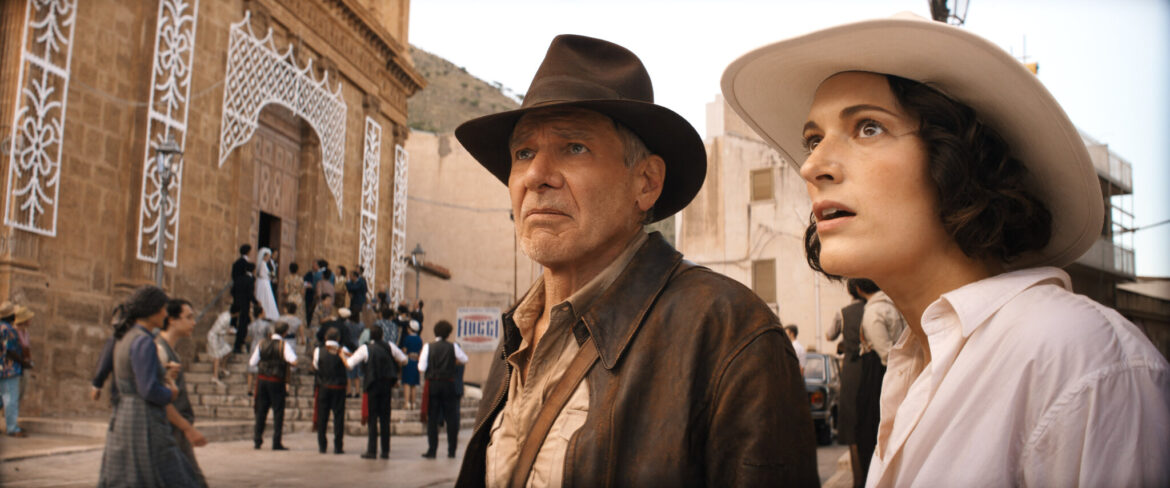Indiana Jones and the Dial of Destiny (2023) marks the conclusion of one of cinema’s most enduring franchises, bringing the legendary archaeologist and adventurer, Dr. Henry “Indiana” Jones Jr., back to the big screen for one final adventure. Directed by James Mangold, this installment offers a blend of nostalgia, action, and emotional depth, providing a poignant send-off to Harrison Ford’s iconic portrayal of the character.
Plot Overview
Set in 1969, twelve years after the events of Kingdom of the Crystal Skull, Indiana Jones is now a weary, retired archaeologist and college professor. His personal life has been marred by tragedy—the loss of his son, Mutt, in the Vietnam War, and the subsequent dissolution of his marriage to Marion Ravenwood. As he contemplates his past and future, Indy is thrust back into the world of adventure when his estranged goddaughter, Helena Shaw (Phoebe Waller-Bridge), arrives seeking his help.
Helena, the daughter of Indy’s late friend and fellow archaeologist Basil Shaw, has come into possession of a fragment of the Antikythera mechanism, an ancient Greek device attributed to Archimedes. This artifact, known as the Dial of Destiny, is believed to have the power to alter the course of history. The film opens with a thrilling World War II-era sequence where a young Indiana Jones and Basil Shaw attempt to retrieve the Dial from Nazi forces. This prologue sets the stage for the central conflict, introducing the antagonist, Jürgen Voller (Mads Mikkelsen), a former Nazi scientist now working for NASA.
In the present day, Voller seeks to reunite the two halves of the Dial to manipulate time and change historical events. As Indy and Helena embark on a globe-trotting quest to prevent Voller from achieving his goal, they encounter various challenges, including betrayals, high-stakes chases, and confrontations that test their resolve and relationship.
Themes and Character Development
At its core, Dial of Destiny explores themes of legacy, redemption, and the passage of time. Indiana Jones, once a symbol of youthful vigor and unyielding determination, now faces the realities of aging and the consequences of his past actions. The film delves into his internal struggle with obsolescence and the desire to reclaim his former glory. This introspection is juxtaposed with the introduction of Helena, a character who embodies the new generation of adventurers—resourceful, bold, and unafraid to challenge the status quo.
The dynamic between Indy and Helena adds depth to the narrative. Initially, their relationship is strained, with Indy viewing her as a reminder of his past mistakes and a symbol of the changing world he no longer understands. However, as the story progresses, their bond strengthens, with Helena serving as both a catalyst for Indy’s return to action and a mirror reflecting his own growth. Their evolving partnership underscores the film’s message that while the past shapes us, it is our choices in the present that define our future.
Action Sequences and Cinematic Craftsmanship
True to the franchise’s roots, Dial of Destiny delivers exhilarating action sequences that keep audiences on the edge of their seats. From daring escapes and intense shootouts to intricate puzzles and narrow escapes, the film showcases the high-octane adventure that fans have come to expect. The use of practical effects, combined with modern CGI, ensures that the action feels grounded and authentic, maintaining the series’ signature blend of realism and spectacle.
The film’s cinematography, helmed by Phedon Papamichael, captures the diverse locales with stunning visuals. Whether it’s the bustling streets of Tangier, the ancient ruins of Greece, or the neon-lit cityscapes of 1960s New York, each setting is meticulously crafted to immerse viewers in the story’s world. The attention to detail in production design further enhances the authenticity, making each scene feel lived-in and rich with history.
John Williams’ Musical Legacy
A standout element of Dial of Destiny is the return of composer John Williams, whose iconic scores have been integral to the Indiana Jones series since its inception. Williams’ final contribution to the franchise is both nostalgic and innovative, weaving familiar themes with new compositions that reflect the film’s emotional depth and narrative evolution. The score amplifies the film’s tone, elevating key moments and adding resonance to the characters’ journeys.
Critical Reception and Legacy
Upon its release, Indiana Jones and the Dial of Destiny received generally positive reviews from critics and audiences alike. The film was praised for its heartfelt storytelling, Harrison Ford’s compelling performance, and the dynamic between the lead characters. While some critics noted that the film occasionally relied on familiar tropes, many felt that it successfully honored the legacy of the franchise while introducing fresh elements to captivate a new generation of viewers.
Financially, the film performed well at the box office, though it did not reach the monumental heights of its predecessors. Despite this, Dial of Destiny is considered a fitting conclusion to the saga, providing closure to long-standing character arcs and themes. The film’s exploration of aging and legacy resonates with audiences, offering a poignant reflection on the passage of time and the enduring nature of heroism.
Conclusion
Indiana Jones and the Dial of Destiny stands as a testament to the enduring appeal of its titular character and the timeless nature of adventure storytelling. By blending action, emotion, and introspection, the film delivers a satisfying conclusion to the saga, honoring its past while embracing the future. As the final chapter in Indiana Jones’ cinematic journey, Dial of Destiny ensures that the spirit of adventure lives on, leaving audiences with a sense of fulfillment and nostalgia for the adventures that have captivated them for decades.

